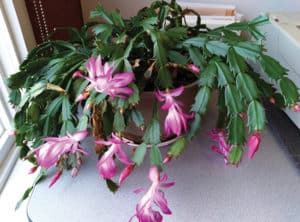By Deborah J. Benoit, Extension master gardener, University of Vermont
It’s that time of year again when amaryllis, Christmas cactus and poinsettias appear in stores and find their way into our homes. Whether you receive a new plant as a gift or purchase it, it’s always a good idea to familiarize yourself with the plant’s needs and any safety concerns it might present.

The Christmas cactus, a popular holiday potted plant, produces stunning tubular flowers.
Amaryllis (Hippeastrum) is easily recognized by its tall flower stalk topped with multiple large, trumpet-shaped flowers. It’s available as a bulb ready to plant or already flowering.
This popular holiday plant is easy to care for. Just provide some light, and keep the soil moist, but not wet. Turning the plant regularly will help the stalk grow straight rather than lean into the light.
Keep amaryllis out of reach of pets and children. The bulb, leaves and flowers contain toxins that can cause abdominal pain, vomiting and other physical distress.
After the flowers have faded, remove them. Continue to water and enjoy the foliage until the leaves begin to die, and then cut them back.
Store the bulb in a cool, dry place until you’re ready to plant it again in the fall. For more information on growing amaryllis, go to go.uvm.edu/amaryllis.
Christmas cactus (Schlumbergera bridgesii) generally is available to purchase during November and December. It’s an attractive plant with arching branches and colorful flowers.
If you receive or bring home a Christmas cactus, place it in a bright window for the winter season. Water when the soil begins to dry out, but don’t let the soil dry completely or buds may drop.
Likewise, don’t over water. Soggy soil can lead to root rot. With minimal care, those bright blooms should last 4-6 weeks, plenty of time to enjoy through the holidays and into the new year.
Christmas cactus is an easy-care houseplant that can last for many years. Once the flowers have faded, continue to water as needed. Place in bright, but indirect light during the summer when sunlight will be more intense and could burn the leaves.
You also can move it outdoors while temperatures remain above 50 degrees Fahrenheit. Gradually acclimate it to the stronger sunlight as you would seedlings in the spring. Be sure to bring it back indoors before the danger of frost returns.
And if you decide you want more?
Christmas cactus roots easily in water. Just remove a section with several segments and place in water. Once roots have grown to at least an inch, the new plant can be potted up using a potting soil or cactus mix.
Christmas cactus is not poisonous to humans or pets, but ingesting the fibrous leaf segments may cause digestive issues.
Poinsettias (Euphorbia pulcherrima) seem to be everywhere during the holiday season. The plant’s showy “flowers” are not really flowers at all but leaves called bracts that have changed color. The real flower is hidden at the center of the bracts.
Perhaps the best thing you can do to keep your poinsettia happy is to remove that pretty foil covering its pot. The foil will capture water and keep the soil too wet. And be sure to provide lots of light.
The poinsettia is not considered poisonous. Its milky white sap may cause skin irritation, and if eaten, result in a mild stomach ache, vomiting or diarrhea.
If you’re interested in keeping your poinsettia after the holidays and coaxing it to bloom again, you’ll find more information at go.uvm.edu/poinsettia.




